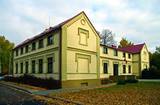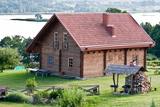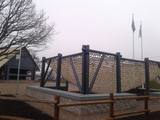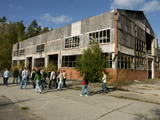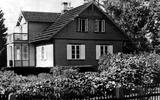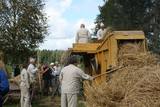| Nr | Nosaukums | Apraksts |
|---|---|---|
|
1888. gadā barons Aleksandrs Aleksejs fon Pistolkorss dāvināja Pēterupes luterāņu draudzei doktorāta ēku ārsta vajadzībām. Kopā ar ēku Pistolkorss pēterupiešiem dāvāja 6 ha zemes un 10 000 rubļu lielu naudas summu, kura bija paredzēta ārsta uzturēšanai. Kā pirmais Pēterupes ārsts šeit sāka strādāt Arvēds fon Engelhards. 1890.gadā doktorāta vienā istabā tiek atvērta pirmā aptieka plašā apkārtnē, kura šinī ēkā atradās līdz 1895.gadam. Doktorāts ir pati pirmā mūra ēka Saulkrastos, pirmā veselības aizsardzības iestāde plašā apkārtnē, kā arī pirmā aptieka. Tā ir māja, kura visu mūžu tika uzturēta no brīvprātīgi saziedotiem līdzekļiem – vispirms Aleksandra Alekseja fon Pistolkorsa, pēc tam Pēterupes draudzes baznīcēnu, tātad ciema iedzīvotāju naudas. |
||
|
Latvijas un Baltijas resnākais parastais osis (Fraxinus excelsior). Aug blakus Zīlēniem - latviešu gleznotāja Ģederta Eliasa memoriālam muzejam, kamdēļ ieguvis otru nosaukumu – Eliasa osis.
|
||
|
Viena no augstākajām Latvijas kāpām. Gan pati kāpa, gan arī tās apkārtnē esošās kāpas ir apaugušas ar skujkoku mežu (mežainas jūrmalas kāpas). Atrodas Bernātu dabas parkā. |
||
|
Atrodas ezera Vilkokšnio ezera krastā - attālā dabas nostūrī, kur smelties spēku un enerģiju. Pirts, guļamistabas ar koka smaržu, vasaras lapene, kamīns, rotaļlaukums, peldēšanās ezerā, makšķerēšana, sporta laukumi, laiva, ūdens velosipēdi, kalnu velosipēdi un kempings. Lauku sētas entnogrāfiskajā istabā tiek cepta mājas maize. Iepazīsieties ar senajiem piederumiem, maizes cepšanas tradīcijām un paražām.
|
||
|
Maršruts iekļaujas kā Latvijas, tā arī Igaunijas valstu robežās. Tā kopējais ilgums ir 9 dienas, ar iespēju paplašināt līdz 12 dienām. Maršruta galvenā mērķauditorija ir neatkarīgi, individuāli ceļotāji, pārvietošanās noris ar velosipēdu un pat ar kanoe laivu. Kopējais maršruta garums sasniedz ~ 446 km riteņbraucienā un ~ 7 km laivošanā. Maršruta galvenais ceļš: Rīga - Gaujas Nacionālais Parks - Otepaa - Upe Ahja - Tartu - Lahemā Nacionālais Parks - Tallina. |
||
|
Meklējama Tārgales ciema centrā. 2018. g. nogalē atklāta Lībiešu zvejnieku sēta ar dzīvojamo māju, kurā ir saimes galds un soli, kūti, tīklu žāvētavu un mākslīgi radīts kāpas fragments. Sēta veidota kā atklāta tipa objekts un to var apmeklēt jebkurā laikā. Apkaimē saglabātas vietējās koku sugas. |
||
|
Atrodas 0,9 km no Jaunpiebalgas muižas pils, Jaunpiebalgas centra virzienā. Redzot šo ēku, nav jāpārliecina, ka tā ir viena no garākajām Vidzemē. Tik gara, ka grūti pat „iedabūt kadrā”. |
||
|
Maršruts sākas populārākajā Latvijas kūrortā - Jūrmalā. Tas piemērots gājējiem, kam patīk iet gar jūras krastu, kur mijas gan ar savdabīgo piekrastes šarmu apvītie bijušie zvejniekciemi, gan mazskartas un vientuļas pludmales. Daudzviet ciemos darbojas mazas lauku kūpinātavas, kur ceļotājiem piedāvā žāvētas zivis. Maršruta galamērķis ir Kolkasrags, ko slavenais Latvijas jūrskolas dibinātājs Krišjānis Valdemārs uzskatīja par Eiropas centru. Kolkasrags kā viena no Baltijas jūras bīstamākajām kuģošanas vietām ir pazīstams jau no vikingu laikiem. Kolkasrags ir arī viena no Latvijas putnu vērošanas „top” – vietām. Maršruta informācija no Latvijas Lauku foruma |
||
|
Amata ir viena no straujākajām Latvijas upēm, tādēļ pavasaros šeit pulcējas ūdenstūristi – sportisku aktivitāšu un asu izjūtu cienītāji! Lejpus Rīgas-Veclaicenes autoceļa Amata ieplūst dziļā ielejā, kur upes vidējais kritums pārsniedz 3 m/km, lejtecē sasniedzot pat 8 - 10 m/km. Ūdenstūristi parasti izmanto upes posmu no Melturiem līdz Zvārtes iezim vai Līgatnes–Kārļu ceļa tiltam (Veclauču tilts). Taču jāatceras, ka Amata nav domāta iesācējiem! Pēc ilgstošām lietavām upe var būt braucama arī citos gadalaikos. Amatas ieleja ir pievilcīga ar saviem iespaidīgajiem smilšakmens un dolomīta atsegumiem, sauktiem par iežiem, no kuriem zināmākie ir Vizuļu iezis (te var veidoties skaists leduskritums), Ainavu krauja, Ķaubju iezis, Dzilnas iezis, Zvārtes iezis un Lustūzis. No Melturiem līdz Veclaužu tiltam gar upes labo krastu ir nomarķēta (oranži punkti uz koku stumbriem) t.s. Amatas ģeoloģiskā taka. Takai ir trīs posmi: Melturi – Kārļu zivjaudzētava, Kārļu zivjaudzētava – Zvārtes iezis (abi posmi var būt ekstrēmi!) un Zvārtes iezis – Veclauču tilts. Pārgājienu var veikt jebkurā laikā, izņemot dziļā sniegā. Iespaidīgākie skati būs vērojami bezlapu laikā. Tiesa, braucot ar laivu, atsegumu vērošanai un fotografēšanai nesanāks laiks, jo būs jākoncentrējas uz šķēršļiem upē. |
||
|
Latvijai samērā unikāla teritorija – gāršas tipa mežs, kurā aug ozoli (daudz dižozolu), liepas, oši u.c. lapukoki. Vietējā gida – mežziņa pavadībā var izstaigāt nelielu gāršas nogabalu, iepazīt raksturīgākos gāršas apdzīvotājus un to nozīmi. Ukru gārša – dabas liegums
|
||
|
Atklāta teritorija 3,5 km garumā un 2 km platumā, kas atrodas Lielupes kreisajā krastā starp Pavasaru ciemu un Odiņu mājām. Polderis veidots padomju laikā ar mērķi iegūt lauksaimniecībā izmantojamās zemes un tolaik arī intensīvi izmantots. Mūsdienās tas pamazām aizaug. Neskatoties uz to, šeit ir Eiropā novērotais lielākais griežu blīvums. Ziemeļu – dienvidu virzienā polderi šķērso grantēts ceļš, kas ir piemērota vieta griežu klausīšanai. |
||
|
Viens no iespaidīgākajiem bijušās PSRS armijas objektiem Ziemeļvidzemē ar pamestām ēkām, pazemes bunkuriem, raķešu noliktavām, to palaišanas laukumiem u.c. elementiem. Viena no dažām vietām Latvijā, kur redzams Ļeņina piemineklis. Akmenī kaltais Ļeņina galvas atveids padomju gados bija novietots Alūksnes centrālajā laukumā. Atmodas laikā to demontēja un pārveda uz kodolraķešu bāzi. Īpaši slepens militārs objekts, kas ir spilgta Aukstā kara liecība. Bāzē aizvien labi saglabājušies dažādi angāri, raķešu palaišanas laukumi un bumbu patvertnes. Objektu var atklāt individuāli, kopā ar vietējo gidu vai izmantojot audio gida sniegtās iespējas. Iesakām ceļojumu laikā sākt Zeltiņu vēstures krātuvē, kur dota iespēja ieskatīties padomju laika sadzīvē un uzzināt par darbību padomju armijas raķešu bāzē! |
||
|
Saimniecībā žāvē cūkgaļu, taisa asinsdesas un ražo citus gaļas izstrādājumus. Saimnieks piedāvā ekskursiju un žāvējumu iegādi. |
||
|
Atrodas Viesītes rietumdaļā - Kaļķu ielas malā uz t.s. Vales kalniņa (ledāja veidots oss). Kā interesants ir jāmin fakts, ka 1919. g. šajā vietā Viesītes aizstāvji sakāva bermontiešu armiju. Baznīcas pamatakmeni lika 1937. g. 15. augustā (Varoņu piemiņas dienā), iesvētīja 1939. g., bet atjaunoja 1994. gadā. Dievnama celtniecību finansiāli atbalstījis profesors Pauls Stradiņš. Tajā atrodas L. Caunes altārglezna. Austrumos no baznīcas –Vales kalniņa piekājē uzstādīts P. Stradiņam veltīts piemineklis.
|
||
|
Kaltenes luterāņu draudzes un baznīcas vēsture aizsākusies 1567. gadā, kad Kurzemes hercogs Gothards Ketlers izdevis pavēli būvēt Kurzemē jaunas baznīcas. Kā viena no tām tapusi arī baznīca Kaltenē. Tā saukusies par Svētās Katrīnas baznīcu. 1848. gadā vecās koka baznīcas vietā uzcelta baznīca no māla kleķa. 1880. gadā tai piebūvēta sakristeja, bet pati baznīcas ēka tikusi pārbūvēta un paplašināta 1896. gadā. Tā cietusi pirmā pasaules kara laikā no krievu mīnu kuģa šāviņa. Baznīca atjaunota 20.gs. divdesmito gadu pirmajā pusē. Kaltenes baznīcas altārgleznu „Kristus un Sv. Pēteris uz jūras” gleznojis M.Pols 1898. gadā (pēc R.Rihtera darba motīviem).18.gs. darinātā kancele un ērģeles, kas atrodas baznīcā ir valsts aizsargājamie kultūras pieminekļi. Ērģeles būvējis ērģeļu speciālists Augusts Martins 1843. gadā, un tās sākotnēji uzstādītas Gulbenes baznīcā. 1943. gadā ērģeles pārvestas uz Kaltenes baznīcu. Šīs ērģeles ir vecākais līdz mūsdienām saglabājies A.Martina būvētais instruments. Baznīcas zvans izgatavots 2006. gadā „Liepājas Metalurgā”. 2012. - 2013. gadā pie baznīcas uzcelta jauna draudzes māja. Pie baznīcas vārtiem uzņemti pirmie kadri kinofilmai "Ilgais ceļš kāpās", kā arī "Meldru mežs". Turpat netālu atrodas mājas ar nosaukumu „Putniņi”. 1921. g. šajās mājas Kaltenē viesojies pats tā laika Kultūras ministrs Rainis. Šeit tajā laikā atradās veikals. 2. pasaules kara laikā vācieši nodedzināja vecās Putniņu mājas. (Avots: Rojas TIC) |
||
|
Šis avots ir pazīstams kopš seniem laikiem. Kalpo kā laba dzeramā ūdens ņemšanas vieta. |
||
|
Atpūtas vieta "Buki" atrodas Ventspils novadā, Baltijas jūras piekrastes aizsargjoslā. "Buki" ir klusa vieta atpūtai, kur iespējams baudīt Latvijas lauku mieru. Piedāvā atpūtu ģimenēm ar bērniem, draugu kompānijām vai vienkārši dabu mīlošiem cilvēkiem. Atpūtas vietas teritorija ir labiekārtota un tajā ir iespējama makšķerēšana piemājas dīķī, sporta aktivitāte kā volejbols, kā arī teritorijā ir atrakcijas bērniem - batuts un šūpoles. Nakšņošanas iespējas 6 veidu kotedžās, 3 veidu numuros viesu namā un 2 brīvdienu dzīvokļos, kā arī teltīs un treilerī. "Buki" piedāvā vietas svinībām gan lapenēs, gan svinību teltī (līdz 100 personām), arī divas pirtiņas. Atpūtas vietas teritorijā ir mini ZOO, kurā iespējams ne tikai dzīvē ieraudzīt dažādu sugu un dzimtu pārstāvjus, bet arī tos apčubināt un pabarot. Mini ZOO var sadzirdēt pērļu vistas, dziedošu ēzeli Janci, redzēt krāšņo pāva asti, izbaudīt alpakas un lamas vilnas mīkstumu, satikt aci pret aci dažādus kamieļus un daudz ko citu. Tāpat saimnieki piedāvā dažādu mājražojumu (kūpināta gaļa un zivis, kazas siers, olas, desas, sezonas augļus un dārzeņus u.c. produkti) degustācijas. |
||
|
Pirmā latviešu romāna “Mērnieku laiki” līdzautors Reinis Kaudzīte Pēterupes ciemā uzturējās kopš 1913. gada. |
||
|
The road trip from Vilnius to Rīga will take you to the most beautiful and important sightseeing places of the Next on the route is the Dubysa Regional Park, which includes the spectacular Dubysa river valley, historic churches and mounds along its banks. Be prepared, since the terrain of this area is rather rolling. Next, you will visit the town of Šiluva, which is a Catholic pilgrimage site, and then travel to the Tytuvėnai Regional Park, where you walk the natural trail of the lake of Gilius, which is part of the Forest Trail. The tour will continue in the Kurtuvėnai Regional Park, where you will walk one section of the Forest Trail from Kurtuvėnai to Šaukėnai, leading along small forest trails, educational trails, beautiful tree alleys and through wetlands. Then you will go to the region of Samogitia, visiting Telšiai and walk one of the Forest Trail sections along Lake Plateliai. Next, the tour takes you through the stone town of Mosėdis to Latvia, where you will stop over to have a walk on one of the oldest towns in Latvia – Aizpute, enjoying its 19th century wooden architecture and the local wine brewery. Next you will take a small walk along the Forest Trail in the eye-catching Kazdanga manor park and drive on to the most beautiful town of Kurzeme – Kuldīga. At the end of the tour, you will walk a section of the Forest Trail along the Abava River Valley Nature Park and nature trails in the Ķemeri National Park. |
||
|
Kurgjas lauku muzejā var iepazīties ar Igaunijas 19. gadsimta atmodas laika dižvīra Kārļa Roberta Jākobsona dzīvi un darbu, ar viņa celtās lauku sētas ikdienas rūpēm. Tā kā lauku sētā līdz pat šodienai saimnieki nodarbojas ar lopkopību, var iepazīt liellopus, aitas un zirgus, ieskatīties restaurētajās palīgēkās – govju kūtī, klētī, dzirnavās un rijā. Lauku darbus var izmēģināt arī paši. Pēc pasūtījuma muzejā iespējams nobaudīt nacionālos ēdienus. |
||
